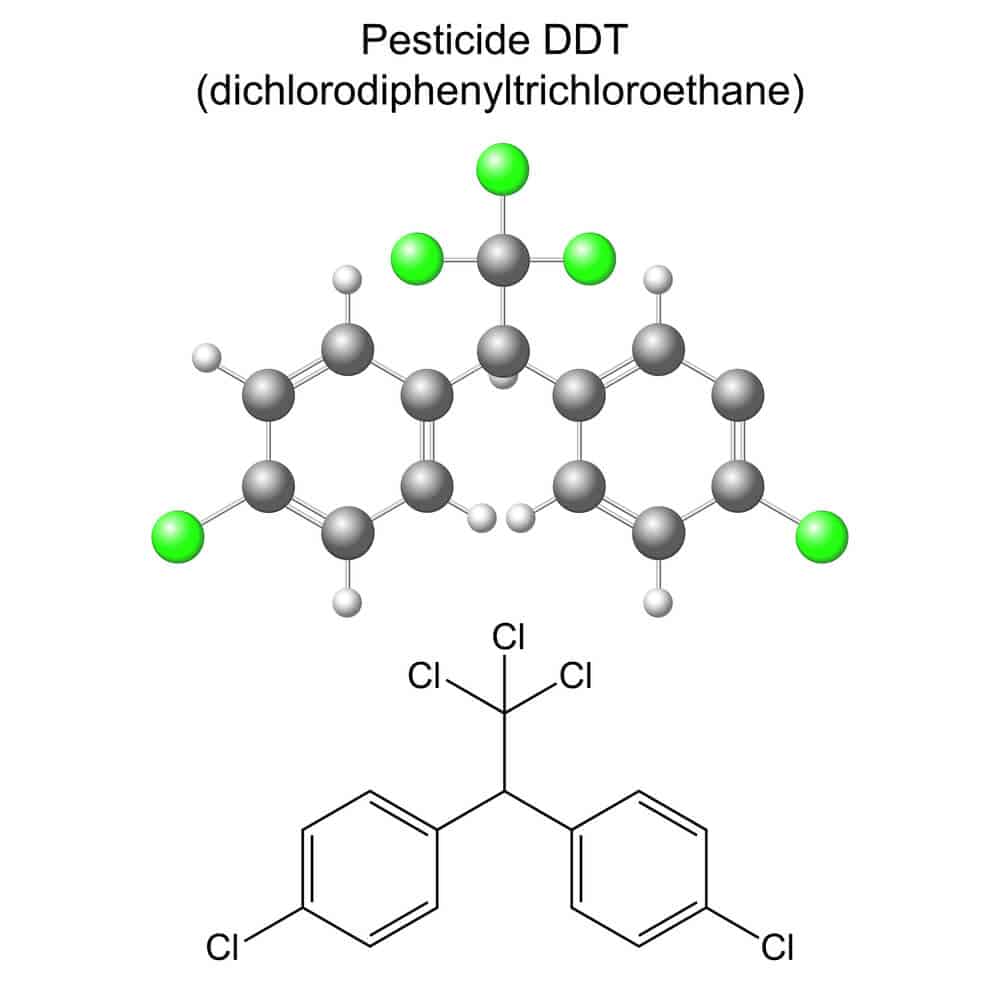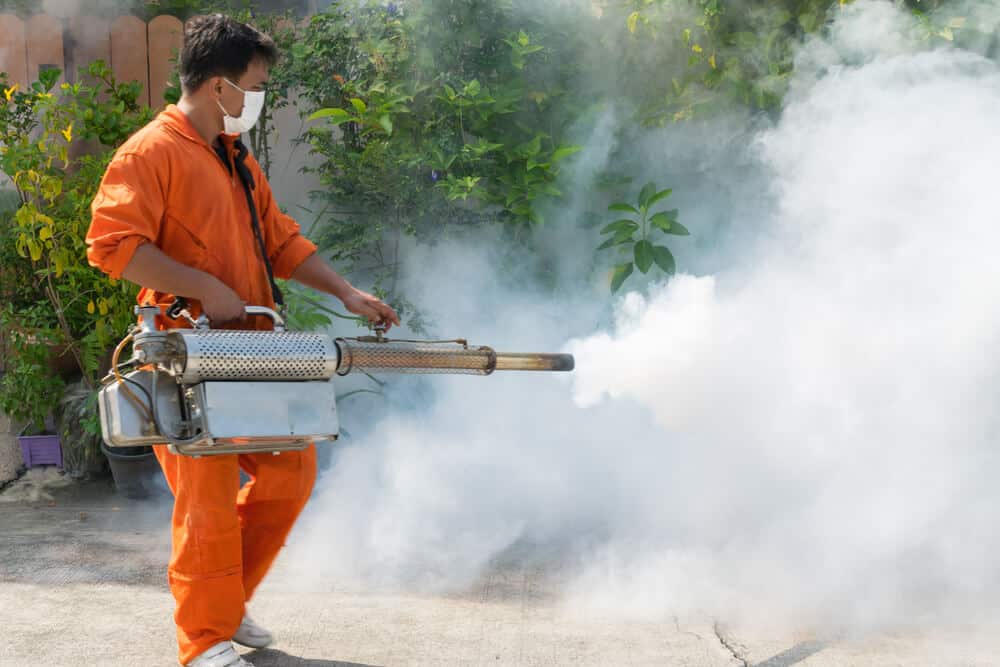Is DDT still used? I thought that plastics, polythene, glass objects, among others, are the only environmental pollutants when poorly disposed of.
Surprisingly, Dichlorodiphenyltrichloroethane isn’t an exception.
Initially, DDT helped to fight malaria and other insect-borne human diseases.
Although the U.S. Department of Agriculture began regulatory actions to ban many DDT’s uses, organic halogen combats insects in crops, homes, institutions, livestock production, and gardens.
As an eco-conscious consumer, I reached out to debunk the role of DDT in the environment. So, is DDT biodegradable?
What is DDT?
DDT or Dichlorodiphenyltrichloroethane is a crystalline, colorless, tasteless, and nearly odorless chemical compound.
People used it as an insecticide or pesticide on a global scale.
It belongs to the family of moderately toxic, organic halogen compounds.
If this is something to go by, then DDT can pose a challenge to the environment and our health.
Is DDT Biodegradable?
No. DDT is non-biodegradable. It’s a persistent organic pollutant that can’t decompose into simple, harmless substances in nature.

To date, no action by microbes can degrade when it accumulates by a process called biomagnification or bioaccumulation. Because of this, it can cause harm to the environment.
While it’s toxic, many countries like the U.S. regulate its usage, citing that it exerts health risk.
The international boundaries classify it as a probable human carcinogen.
Does DDT decompose Quickly?
Yes, it takes 2 days to decompose in the air and 2-15 years in the soil. Once in the environment and in the presence of sunlight, DDT breaks down rapidly.
After extensive exposure to the air, DDT will take only 2 days to break down.
However, it sticks to the soil. The extensive exposure to the soil makes it decompose slowly but into DDD and DDE.
The microorganisms are responsible for this.
Environmentalists report that its half-life is between 2 and 15 years.
Its decomposition rate depends on the type of soil, though.
How Is DDT Bad For The Environment?
Studies show that DDT is a threat to the environment. As usual, there must be reasons for this.
As a non-biodegradable class 2 insecticide, DDT is not only toxic but also moderate-soluble in water.
Scientifically, DDT breakdown products (DDE and DDD) dissolve in water. So, the considerable amount will deliquesce into groundwater.
DDE builds up in the fatty tissues of birds, fish, and other aquatic lives without forgetting the plants.
Here are the reasons why DDT is harmful to the environment;
- Accumulates in fatty tissues
- It’s persistent in the environment
- Moderate-soluble in water
- Can reach or travel easily in the upper atmosphere
Since it has persistent characteristics, the metabolite (DDE) is thought to cause eggshell thinning in birds.
The small amount of original DDT decreases the calcium in eggs laid by birds.
Due to its solubility feature, DDT shows devastating effects on aquatic life.
Its presence in water through the process known as bioaccumulation poses long-term challenges to the marine environment, including fish species and wildlife.
Given its toxicity ratio, DDT kills aquatic invertebrate species in no time. Even its traces alter the insecticidal activity of flies.
It kills insects upon contact.
Remember that flies like grasshoppers help in pollinating plants. Again, some flies are food for other animals.
What about DDT effects on human health? Exposure to DDT may result in diarrhea, nausea, skin irritation, throat, nose, and eyes.
Human beings may suffer from liver, kidney, immune system disorders, and nervous system problems.
Following exposure to moderate and high doses, human health effects can include tremors, vomiting, and seizures. Other studies say that DDT could be a possible human carcinogen.
People living with pancreatic cancer, leukemia, and lymphoma do experience health implications.
How Long Does DDT Last in Environment
DDT can last in the soil for 2-15 years, and in air, it takes 2 days to decompose.
DDT will moderately dissolve in water, thus sticking to soil particles. That way, it will take a long time to get to underground water.
A significant percent of DDT evaporates into the air while some of its products are broken down by microscopic plants and sunlight or animals in the surface water or soil.
What Are the Long Term Effects of DDT?
DDT isn’t eco-friendly. Its usage comes with negative impacts on the environment to human beings, birds, and aquatic life.
These include:
- Kills aquatic wildlife
- Moderate exposure to DDT may irritate your nose, eyes, and throat
- High doses can result in convulsions and tremors
- Causes chronic effects on the immune system in animals
- Responsible for eggshell thinning in birds
How do human beings get exposed to DDT?
- By eating contaminated foods such as fish, leafy vegetables, poultry
- Drinking contaminated water
- Breathing contaminated air
- Swallowing soil particles
Why Should DDT be Banned?
DDT’s ability to travel distances and the long half-life is a concern. That said, it should be banned and phased out.
Some industrialized countries like the U.S. did it a decade ago.
As of now, there’s a special effort to educate, inform and convince about the well-documented environmental hazards of DDT throughout the world.
Conclusion
DDT joins plastic bags, PVC, and other materials as a non-biodegradable pollutant.
The hundreds of thousands of tons of DDT produced every year result in harmful effects on human health and the environment.
There are safer substitutes to use instead.



